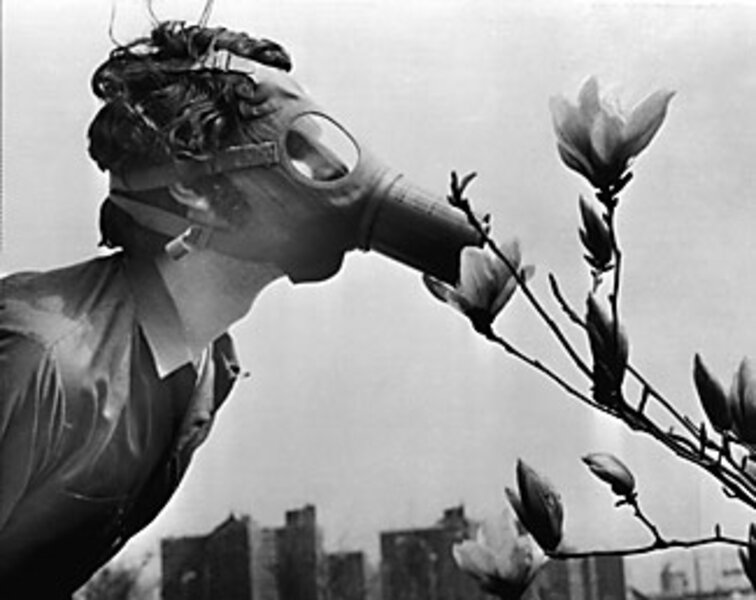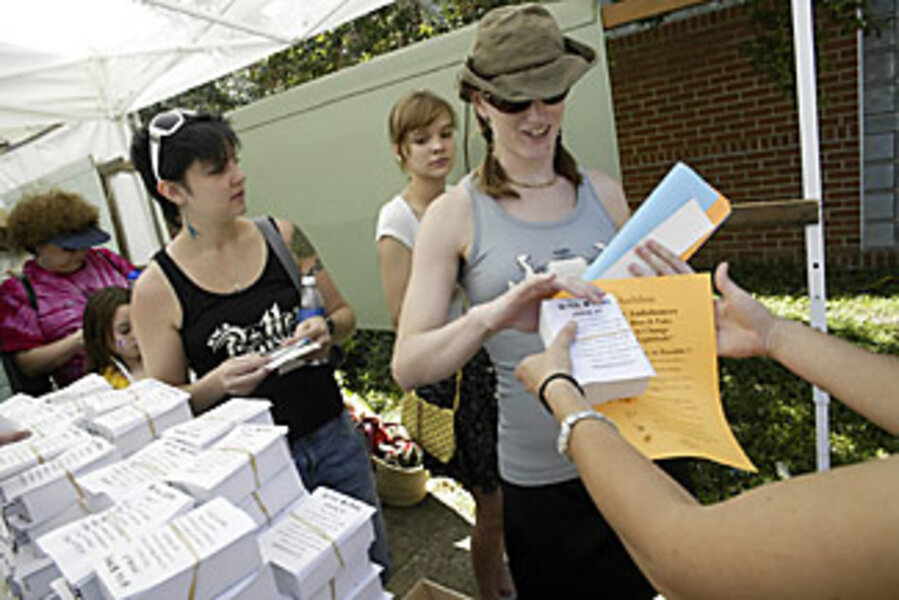How Earth Day became … so everyday
At 38 years old, Earth Day seems to be entering a midlife identity crisis.
By one estimate, some 1 billion people around the world will do something to observe the anniversary of the first Earth Day in 1970, a landmark in the history of the environmental movement. But attitudes and activities will vary widely. While some celebrate nature's beauty and wonder, others will protest environmental degradation and demand action.
Today environmental concerns are aired year-round: Reports from the United Nations and Al Gore's perpetual slide show warn of the dire effects of climate change.
A cable channel called Planet Green debuts June 4, the first TV network to cover the environment full time. Even James Bond gets into the act this fall. The next 007 film, "Quantum of Solace," will feature an ecovillain trying to take over the water supply of a small country.
So where does Earth Day fit in? Everywhere, apparently. "Earth Day is all things to all people. It's a symbolic representative of the desire for everything we need to do to respect how we treat the earth," says Frank Maisano, an energy-industry spokesman in Washington.
Earth Day isn't even a day anymore. While April 22 is the official date, it's grown to become an earth week, an earth month, and more.
"It's the Earth Day 'season,' " says Paul Hawken, author of a book on the environmental and social-justice movements, "Blessed Unrest: How the Largest Movement in the World Came into Being and Why No One Saw It Coming."
An Earth Day with an identity crisis features an odd mix of mourning and celebration, Mr. Hawken says, sort of like a New Orleans jazz funeral. "You cry all the way to the grave, and you dance all the way back," he says. "You mourn what's lost and is being lost, and you celebrate this extraordinary upsurge of groups and organizations and people in the world" who are working on environmental problems.
Some think the day has become as innocuous and uncontroversial as Mother's Day. Others suggest it has succumbed to commercialism. "Is Earth Day the New Christmas?" asks Advertising Age in a story this week.
"It's relaxed into a kind of therapeutic and consumer movement. We buy things to protect the environment," says Paul Sutter, an associate professor of history at the University of Georgia who tracks the environmental movement. "We recycle, but I don't think there's nearly as much of an activist strain as there used to be."
Today's Earth Day Network, a nonprofit that keeps a database of local events and provides help to thousands of activities around the world, descends from a group of young activists in 1970 who answered a plea from then-Sen. Gaylord Nelson (D) of Wisconsin and piled into borrowed space in Washington to start a phenomenon. Denis Hayes, who led the first Earth Day effort, now sits on the Earth Day Network board.
Still an 'entry point'
Despite the year-round attention the environment receives, Earth Day remains a vital "entry point" for people, especially schoolchildren, to begin learning about the issues, says Kathleen Rogers, president of the Earth Day Network.
Today's spotlight on environmental issues has raised interest in Earth Day but also "leads us inexorably to a year-round Earth Day," she concedes.
For the second year in a row, the Chinese government is actively supporting Earth Day. Last year, so many Chinese sought information that it "crashed our website," Ms. Rogers says.
Rallies remain a keystone Earth Day activity. This Sunday, gatherings will be held on the National Mall in Washington and in seven other cities. A petition at www.earthday.net asks Congress to ban the building of coal-fired power plants, increase reliance on renewable energy sources, and require new buildings to be more energy-efficient. "We need Congress to understand something that they don't at all, that Americans really care about this issue," Rogers says.
But much of what the network does involves local efforts. Just days ago Rogers received an e-mail from a woman in Paris, Tenn., who owns a beauty parlor and had heard about Earth Day. The woman wanted to donate 20 percent of her income for the next three months to the Earth Day Network. Rogers says she instead suggested that the woman collect donations from customers and pay to install energy-saving light bulbs in the local high school.
Cleanups remain popular Earth Day projects. On April 20, New York's Central Park will host planting and mulching. In Concord, Mass., Musketaquid Earth Day is May 3 (Musketaquid is the native American name for the area). Small rafts made of pine logs and decorated with other natural materials will be launched onto the Concord River.
"They decompose where they land," says Morwen Two Feathers, coordinator of the Musketaquid Arts and Environment Program. "It's a symbolic way of saying [that] we send things downstream and we don't always know what happens to them."
Businesses mark the day, too. At HOK, a global architectural firm, April 22 is "Go Barefoot Day" as the 2,600 employees make a difference "one step at a time." They're being asked to use no paper that day, trade bottled water for tap water, and take special care to turn off lights and computers whenever not in use. "Like anything, change is hard. But if you change once, you're more likely to do it again," says Mary Ann Lazarus, the firm's director of sustainable design.
What's changed since 1970
While the environment remains the focus, much about Earth Day has changed since 1970, says Adam Rome, an associate professor of history at Penn State University who's working on a book on the subject.
"The first Earth Day was [conceived] partly out of frustration and anger that basic issues like air pollution and water pollution still had not been addressed," he says. Concern over population growth also loomed. "[There was] a sense that something needed to be done to force the leaders of the country ... to take these issues seriously," he says. Global warming was unknown to the general public, though Professor Rome notes that news coverage on April 22, 1970, included a story about a weather-service scientist who said "a lot of evidence" was accumulating to show the earth was warming.
New attention comes from areas beyond the business community. While some churches called for sermons on the topic in 1970, "by and large, institutional religion wasn't interested in environmental issues back then," Rome says. Today, caring for the earth is "a fundamental theological issue," he says.
New environmental concerns have entered the picture too, such as health-related concerns over food-supply safety, Rome says.
The era surrounding the first Earth Day, 1968-73, saw the passage of keystone environmental legislation, including the National Trails System Act and the Endangered Species Act, Professor Sutter points out. The Environmental Protection Agency was founded in 1970 as well.
This year, no major environmental bills are likely to pass Congress, Mr. Maisano says. "We're in a very different situation now," Rome says. "We've addressed a lot of the problems that concerned the people in 1970."






